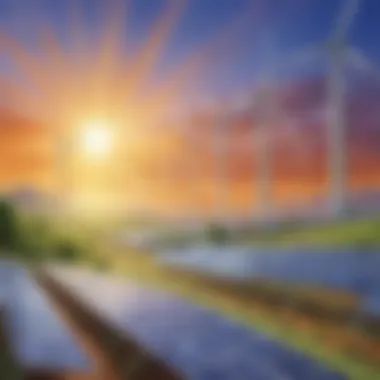Unveiling the Intriguing World of Sustainable Energy for Young Minds


Science Fun Facts
Did you know that wind energy is generated from the movement of air? It's a clean and renewable source of energy that doesn't produce harmful emissions. Imagine harnessing the power of the wind to generate electricity – nature's energy at work!
Discover the Wonders of Science
Exploring various scientific concepts related to alternate forms of energy opens up a world of possibilities. Educational videos and animations can illustrate complex ideas in a fun and engaging way, making learning intriguing and accessible. By showcasing real-life applications of science, young enthusiasts can see how these concepts shape the world around them.
Science Quiz Time
Testing knowledge with interactive quizzes can reinforce learning and make it enjoyable. From multiple-choice questions to brain teasers and puzzles, science quiz time offers a gamified approach to education. It challenges young minds to think critically and creatively while deepening their understanding of alternate energy sources.
Science Experiment Showcase
Experience the excitement of science through fun and engaging experiments. Step-by-step instructions provide a structured approach, ensuring safety and proper understanding. The materials list outlines everything needed, while safety tips and precautions guide young scientists through each experiment methodically.
Introduction to Alternate Forms of Energy
In this section, we will delve into the realm of alternate forms of energy, elucidating on the significance and relevance of exploring diverse energy sources. The transition from conventional to alternative energy is crucial in addressing environmental concerns and resource sustainability for a brighter future. Understanding the dynamics of various energy forms empowers young science enthusiasts to envision a greener, more sustainable world.
Understanding Traditional Energy Sources
Fossil Fuels
Fossil fuels have played a prominent role in meeting global energy demands due to their high energy density and easy accessibility. However, their combustion releases harmful greenhouse gases, contributing to climate change. This section will explore the impact of fossil fuels on the environment and why transitioning to cleaner energy sources is imperative for long-term environmental preservation.
Nuclear Energy
Nuclear energy harnesses the power of atomic reactions to generate electricity without the carbon emissions associated with fossil fuels. The intricate process of nuclear fission offers a reliable energy source, but concerns about radioactive waste disposal and potential safety risks pose challenges. By examining the pros and cons of nuclear energy, young learners can grasp the complexities of this alternative energy form.
Hydropower
Hydropower utilizes the kinetic energy of flowing water to generate electricity through dams and turbines. While hydropower is renewable and efficient, it can disrupt natural habitats and fish migration patterns. This section will delve into the mechanism of hydropower generation and its impact on ecosystems, encouraging a critical analysis of its environmental implications.


Importance of Exploring Alternatives
In this segment, we emphasize the importance of seeking alternative energy sources to mitigate environmental degradation and resource depletion. By scrutinizing the environmental impact and resource scarcity associated with traditional energy sources, young minds can recognize the urgency of embracing sustainable energy solutions.
Environmental Impact
The environmental impact of energy production encompasses factors such as air pollution, water contamination, and deforestation. Exploring eco-friendly alternatives like solar and wind power can significantly reduce these adverse effects, paving the way for a cleaner and healthier planet. This subsection will elucidate the environmental benefits of transitioning to renewable energy sources.
Resource Depletion
Resource depletion refers to the gradual exhaustion of non-renewable resources like coal and oil, jeopardizing future energy security. By investigating the finite nature of traditional energy sources, children will understand the importance of conserving resources and adopting renewable energy technologies. Analyzing the concept of resource depletion can instill a sense of responsibility towards sustainability among young science enthusiasts.
Renewable Energy Sources
Renewable energy sources play a pivotal role in the quest for sustainable energy solutions. By harnessing natural elements like sunlight, wind, and water, renewable energy offers a clean and abundant alternative to traditional fossil fuels. In this article, we delve into the importance of renewable energy sources, emphasizing their environmental benefits and long-term sustainability. Understanding the significance of renewable energy is crucial for young science enthusiasts as they explore innovative technologies shaping the future landscape of energy production.
Solar Power
Solar Panels
Solar panels, a cornerstone of solar power technology, convert sunlight into electricity through photovoltaic cells. These panels are lauded for their efficiency in capturing solar energy and reducing carbon emissions. A key characteristic of solar panels is their ability to generate electricity silently and without moving parts, making them a reliable and eco-friendly choice for powering homes and businesses. The unique feature of solar panels lies in their scalability, allowing for installations as small as a single panel on a rooftop to expansive solar farms covering acres of land. While solar panels contribute significantly to sustainable energy solutions, factors like upfront costs and variations in sunlight exposure across regions are essential considerations.
Solar Farms
Solar farms, large-scale installations of solar panels, represent a collective effort to harness solar energy efficiently on a broader scale. These farms are positioned strategically to maximize sunlight exposure and generate substantial amounts of electricity for local communities or national power grids. The key characteristic of solar farms lies in their ability to offset greenhouse gas emissions and reduce dependence on non-renewable energy sources. Choosing solar farms as a renewable energy option offers benefits like land optimization and centralized electricity production. However, challenges such as land requirements, intermittency of sunlight, and maintenance costs underline the need for continuous innovation and integration with energy storage systems.
Wind Energy
Wind Turbines
Wind turbines, the iconic structures of wind energy generation, harness the power of wind to produce electricity. These towering turbines operate by capturing the kinetic energy of the wind and converting it into rotational motion to generate power. A key characteristic of wind turbines is their scalability, with installations ranging from small turbines for individual homes to massive wind farms powering entire regions. The unique feature of wind turbines lies in their low operating costs and minimal environmental impact compared to fossil fuel-powered plants. Despite their advantages, challenges like fluctuating wind speeds and visual impact on landscapes must be considered when incorporating wind energy into the energy mix.
Offshore Wind Farms
Offshore wind farms represent a frontier in wind energy development, situated in bodies of water to harness strong and consistent offshore winds. These farms offer higher wind speeds and smoother airflow, increasing energy output compared to onshore installations. The key characteristic of offshore wind farms is their potential to deliver large-scale renewable energy to coastal areas with limited land availability. Opting for offshore wind farms presents advantages such as reduced visual impact on land and access to abundant wind resources. However, factors like construction and maintenance logistics in challenging marine environments pose technical and financial challenges for offshore wind projects.


Hydroelectric Power
Dams and Reservoirs
Hydroelectric power plants, utilizing dams and reservoirs, generate electricity by capturing the energy of moving water to turn turbines. Dams store water in reservoirs, releasing it through turbines to produce electricity consistently. A key characteristic of dams and reservoirs in hydroelectric power is their ability to provide reliable baseload power and regulate water flow for irrigation and flood control. The unique feature of hydroelectric power lies in its capacity for large-scale energy production and reservoirs serving dual purposes of energy storage and water management. While hydroelectric power contributes to renewable energy portfolios, considerations like habitat disruption, silt accumulation, and emission of methane gases from reservoirs necessitate careful planning and environmental monitoring.
Tidal Energy
Tidal energy, derived from the gravitational pull of the moon and sun on Earth's tides, offers a predictable and renewable source of power. Tidal energy technologies like tidal stream generators harness the kinetic energy of moving water to generate electricity. The key characteristic of tidal energy lies in its predictability and consistency compared to other renewable sources affected by weather conditions. The unique feature of tidal energy is its minimal environmental footprint, with no carbon emissions or visual impact on landscapes. Despite these advantages, challenges such as high installation and maintenance costs, limited suitable locations, and interactions with marine ecosystems underscore the need for further research and technological advancements in tidal energy.
Emerging Technologies in Energy
Emerging technologies play a pivotal role in shaping the future of sustainable energy. In this article, we delve into the realm of cutting-edge innovations that offer promising solutions to our energy needs. These technologies represent the forefront of scientific advancement, with a focus on efficiency, eco-friendliness, and long-term viability. By exploring bioenergy, geothermal energy, and wave and tidal energy, we aim to provide young science enthusiasts with a glimpse into the exciting possibilities that could revolutionize how we power our world.
Bioenergy
Bioenergy stands out as a versatile and renewable form of energy that holds immense potential for a cleaner and greener future. Within the domain of bioenergy, two key components take center stage: biofuels and biogas.
Biofuels
Biofuels, derived from organic materials such as plants and algae, offer a sustainable alternative to traditional fossil fuels. Their key characteristic lies in their ability to reduce greenhouse gas emissions and lessen our reliance on finite resources. In this article, we examine the unique feature of biofuels, highlighting their adaptability for various applications and their role in mitigating climate change. Despite challenges like food crop competition and land use implications, biofuels continue to be a beneficial choice in our quest for sustainable energy solutions.
Biogas
On the other hand, biogas represents a form of renewable energy produced from the breakdown of organic matter in anaerobic conditions. Its key characteristic lies in being a clean and efficient source of energy that contributes to waste management by converting organic waste into useful fuel. In this article, we shed light on the distinctive feature of biogas, emphasizing its versatility in powering vehicles, generating electricity, and heating spaces. While biogas offers advantages like reducing landfill waste and lowering methane emissions, challenges such as production costs and infrastructure limitations need to be addressed for wider adoption.
Geothermal Energy
Discover the vast potential of geothermal energy as a reliable and sustainable power source that harnesses heat from beneath the Earth's surface. Within geothermal energy, we focus on two main elements: geothermal heat pumps and geothermal power plants.
Geothermal Heat Pumps
Geothermal heat pumps utilize the stable temperature of the earth to provide heating, cooling, and hot water for residential and commercial buildings. Their key characteristic lies in energy efficiency and cost-effectiveness, offering a consistent source of climate control throughout the year. In this article, we explore the unique feature of geothermal heat pumps, highlighting their minimal environmental impact and long-term savings on energy bills. Despite advantages such as reduced carbon emissions and minimal maintenance requirements, factors like installation complexity and upfront costs present challenges for wider adoption.


Geothermal Power Plants
Geothermal power plants tap into the Earth's heat to generate electricity, making use of steam and hot water reservoirs deep underground. Their key characteristic lies in producing continuous and renewable energy without relying on weather conditions or fuel inputs. In this article, we delve into the unique feature of geothermal power plants, emphasizing their low carbon footprint and reliability as a baseload power source. While advantages include minimal operational costs and sustainability, concerns such as site selection and reservoir management pose challenges to expanding geothermal power capacity.
Wave and Tidal Energy
Immerse yourself in the world of wave and tidal energy, where innovative technologies harvest the motion of oceans to create clean electricity. Within this domain, we explore wave energy converters and tidal stream generators to showcase the diverse applications of marine energy.
Wave Energy Converters
Wave energy converters use the kinetic energy of ocean waves to generate electricity, offering a sustainable and predictable power source. Their key characteristic lies in capturing wave movement and converting it into renewable energy, reducing carbon emissions and dependency on non-renewable resources. In this article, we discuss the unique feature of wave energy converters, highlighting their potential for coastal regions and remote communities. Despite advantages like consistency and low operating costs, challenges such as device durability and marine ecosystem impacts require innovative solutions for widespread implementation.
Tidal Stream Generators
Tidal stream generators harness the kinetic energy of tides to produce electricity, utilizing underwater turbines driven by tidal currents. Their key characteristic lies in generating power from the natural ebb and flow of tides, offering a reliable and sustainable energy source. In this article, we examine the unique feature of tidal stream generators, emphasizing their low visual impact and high energy density. While advantages include predictability and minimal carbon footprint, challenges like infrastructure installation and maintenance can hinder the scalability of tidal energy projects.
Future Prospects in Sustainable Energy
Energy Storage Solutions
Energy storage solutions play a pivotal role in ensuring a reliable and efficient transition to sustainable energy sources. They facilitate the integration of intermittent renewable sources into the energy grid, addressing fluctuations in supply and demand. In this section, we examine two key aspects of energy storage solutions – battery technology and pumped hydro storage, shedding light on their roles and contributions to the broader goal of sustainable energy.
Battery Technology
Battery technology stands at the forefront of energy storage solutions, offering portable and rechargeable power sources essential for diverse applications. Its versatility and scalability make it a valuable asset in harnessing renewable energy efficiently. The key characteristic of battery technology lies in its ability to store electrical energy for later use, providing backup power during outages and optimizing energy usage. Despite challenges such as limited lifespan and energy density, ongoing innovations aim to enhance performance and sustainability.
Pumped Hydro Storage
Pumped hydro storage represents a well-established technology for large-scale energy storage, leveraging gravitational potential energy for efficient power generation. By storing excess energy during periods of low demand and releasing it when needed, pumped hydro facilities contribute to grid stability and flexibility. The key characteristic of pumped hydro storage is its high energy efficiency, offering a cost-effective and environmentally friendly method of energy storage. While site-specific requirements and environmental considerations pose challenges, advancements in design and operation continue to drive improvements in its overall viability.
Challenges and Innovations
Addressing the challenges associated with sustainable energy adoption requires a multifaceted approach that combines technological innovation and strategic planning. This section explores two critical facets – grid integration and efficiency improvements – that play pivotal roles in optimizing energy systems and maximizing sustainability.
Grid Integration
Grid integration involves the seamless incorporation of diverse energy sources into the existing power grid, ensuring reliable energy supply and efficient distribution. By enabling the coordination of renewable energy generation with demand patterns, grid integration enhances grid resilience and minimizes reliance on fossil fuels. The unique feature of grid integration lies in its ability to balance supply and demand dynamically, supporting a transition towards cleaner and more resilient energy systems. Despite complexities related to grid stability and regulatory frameworks, ongoing research and policy measures aim to streamline integration processes.
Efficiency Improvements
Efficiency improvements focus on enhancing the performance and effectiveness of energy systems, reducing energy waste and enhancing overall sustainability. Through technological advancements and operational enhancements, efficiency improvements contribute to lower energy costs and reduced environmental impact. The key characteristic of efficiency improvements is their ability to optimize energy production and utilization, promoting resource conservation and emission reduction. Despite initial investment costs and implementation challenges, innovations in efficiency enhancement hold promise for long-term energy savings and environmental benefits.







